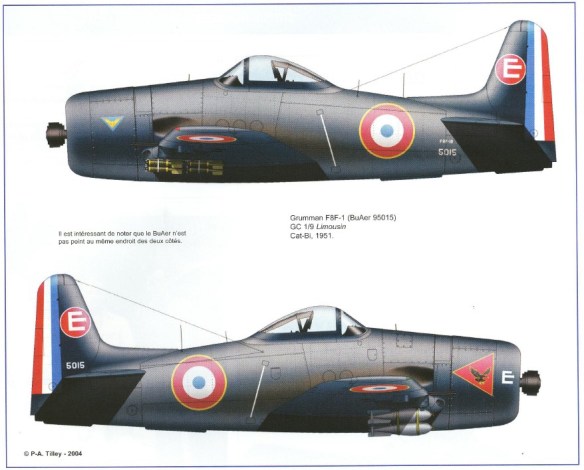The F8F prototypes were ordered in November 1943 and first flew on 21 August 1944, a mere nine months later. The first production aircraft was delivered in February 1945 and the first squadron was operational by 21 May, but World War II was over before the aircraft saw combat service.
Postwar, the F8F became a major U.S. Navy fighter, equipping 24 fighter squadrons. Often mentioned as one of the best-handling piston-engine fighters ever built, its performance was sufficient to outperform many early jets. Its capability for aerobatic performance is illustrated by its selection for the Navy’s elite Blue Angels in 1946, who flew it until the team was temporarily disbanded in 1950, during the Korean War. The F9F Panther and McDonnell F2H Banshee largely replaced the Bearcat in USN service, as their performance and other advantages eclipsed piston-engine fighters.
An unmodified production F8F-1 set a 1946 time-to-climb record (after a run of 115 ft/35 m) of 10,000 ft (3,048 m) in 94 seconds (6,383 fpm). The Bearcat held this record for 10 years until it was broken by a modern jet fighter (which could still not match the Bearcat’s short takeoff distance).
Other nations that flew the Bearcat included the French Air Force and Royal Thai Air Force. French aircraft saw combat service against the Viet Minh in the First Indochina War as fighter-bombers in the early 1950s. They were used to support French Forces at the Battle of Dien Bien Phu, operating at the edge of their combat radius, but failed to prevent the French defeat that brought about the end of the war. Upon its creation in 1955, nearly 70 surviving aircraft passed to the Vietnam Air Force.
Variants
G-58
Company designtation.
G-58A
Two civil aircraft. The first was owned by the Gulf Oil Company for the use of Major Alford Williams, the second one was used by Grumman as a demonstrator aircraft.
XF8F-1
Prototype aircraft, two built.
F8F-1 Bearcat
Single-seat fighter aircraft, equipped with folding wings, a retractable tailwheel, self-sealing fuel tanks, a very small dorsal fin, powered by a 2,100 hp (1,566 kW) Pratt & Whitney R-2800-34W Double Wasp radial piston engine, armed with four 0.50 in (12.7 mm) machine guns.
F3M-1 Bearcat
Planned designation for F8F aircraft constructed by General Motors.
F8F-1B Bearcat
Single-seat fighter version, armed with four 20 mm cannons.
F8F-1(D) Bearcat
Export version for France and Thailand.
XF8-1N
Night fighter prototypes, two built.
F8F-1N Bearcat
Night fighter version, equipped with an APS-19 radar.
XF8F-2
F8F-2 prototypes, two built.
F8F-2 Bearcat
Improved version, equipped with a redesigned engine cowling, taller fin and rudder, armed with four 20 mm (.79 in) cannons, powered by a Pratt & Whitney R-2800-30W radial piston engine, 293 built.
F8F-2N Bearcat
Night-fighter version, equipped with an APS-19 radar.
F8F-2P Bearcat
Photo-reconnaissance version, fitted with camera equipment, armed with two 20 mm (.79 in) cannons.
F8F-1D and F8F-2D
Small numbers of F8F-1s and F8F-2s were converted into drone control aircraft.
